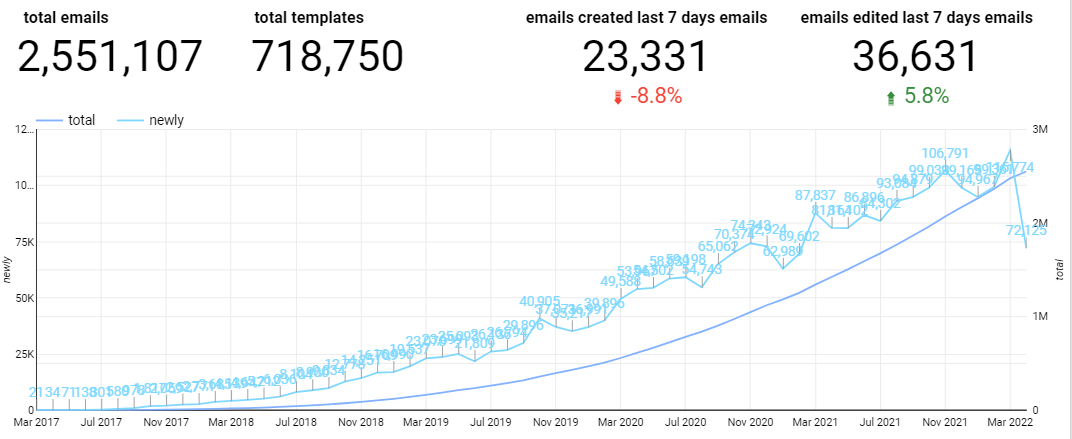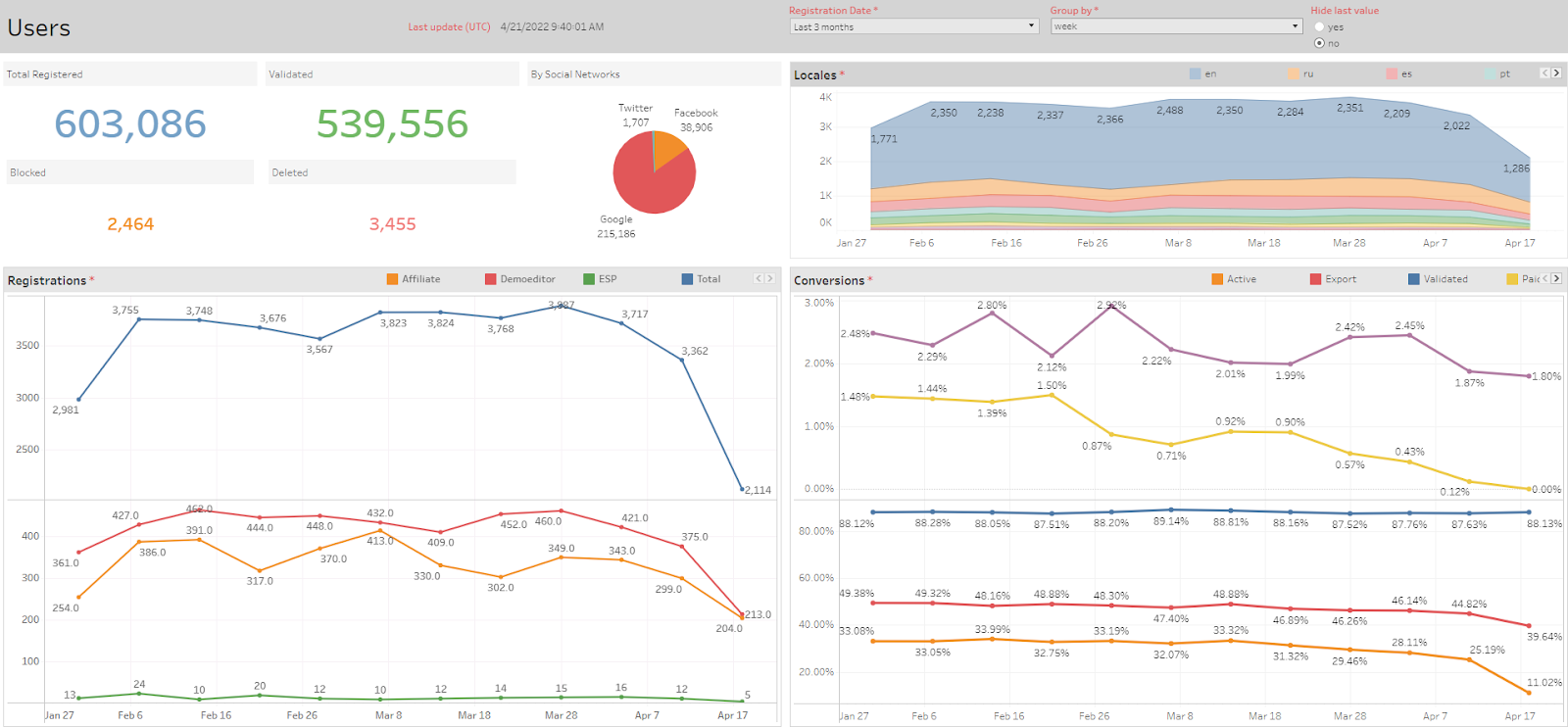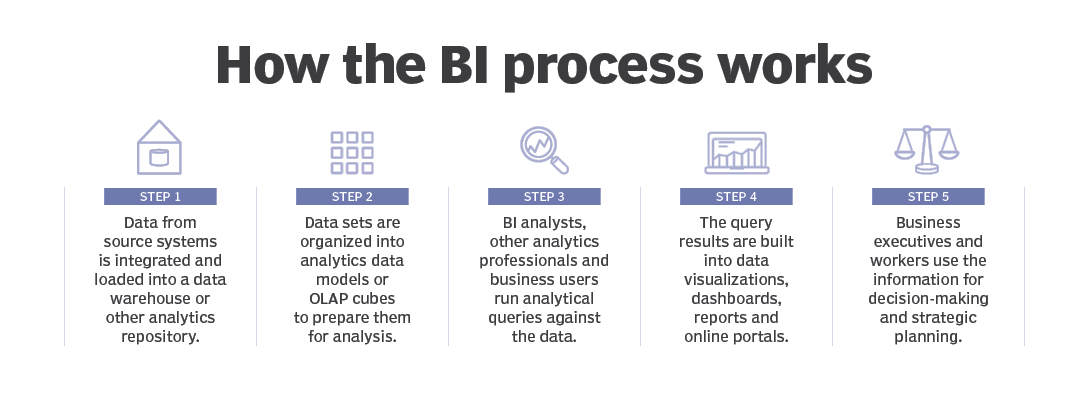Business Intelligence Implementation in 2022
Now many enterprises relies on modern information and business analytics consultancy. This is traditional BI, in-depth analytics (data mining), and the use of artificial intelligence, and machine learning. Companies need information systems that should identify patterns, monitor the achievement of goals, build forecasts, simulate scenarios, and help choose the best solutions.
Such technologies are expected to allow the management of enterprises to look at their activities through the prism of business analysis, understand what has happened and is happening, foresee the future, choose the optimal development strategy and plan specific tactical moves. In addition, the introduction of a business intelligence system will not only improve business efficiency but can also give some image effect to the organization (the system can testify to its “advancement” and level of technical development). People like to engage in innovative projects and the introduction of modern IT technologies is a really exciting process.
But let's look at what consultants who implement BI solutions really face in real projects and how to set it properly.
Importance Of Business Intelligence
This is the process of analyzing historical and current data in order to obtain important analytical information for making management decisions. BI finds applications in completely different areas: sales, finance, marketing, and many others.
The use of business intelligence empowers a company by increasing the amount of data used for analysis. BI provides insight into industry trends and will facilitate the adoption of strategic change.

But the data accumulated by the company and coming from outside tend to get confused and turn into an endless and chaotic stream of information. BI systems make it understandable and accessible for analysis: software systems integrate raw information from all possible sources and convert it for end-users.Why business intelligence matters to today's businesses. Here are the top reasons to invest in a solid BI strategy and system:
- Information about clients
One of the main reasons companies invest their time, money, and effort into business intelligence is because it gives them more power to explore and analyze current customer values.
-
Transparency of work.
Business intelligence helps companies control and analyze their own processes and operations by visualizing them. The days of scrolling through hundreds of pages of annual reports to evaluate performance are long gone. BI helps to identify areas for optimization, thereby allowing you to be ready for external changes, rather than react to them.
- Increasing the efficiency of the company.
BI systems make it easy to share important information between departments, saving time on extracting data and deciphering it. This allows you to get rid of unnecessary operations, functions and responsibilities, allowing employees to focus on their work, and not on data processing.
- Data in real-time.
Often managers and decision-makers have to wait for reports to be produced by different departments. As a result, the data obtained can be subject to human error and risk losing relevance even before it is considered. BI systems provide users with real-time access to data (in the form of spreadsheets, dashboards or emails). Large amounts of data can be collected, analyzed, and displayed quickly and accurately.
Ardas BI System Implementation Case Study
Our custom BI software development solution is designed precisely for software products, mainly for SaaS businesses but could be adopted for other types of products. We created it for our own products 4 years ago when we realized that existing solutions didn’t satisfy business needs and couldn’t provide the required level of customization. We started from scratch in Google Data Studio and then shifted to Tableau. A year ago we realized this solution is probably the best way to do BI for products that need to evolve effectively and started to suggest it to our customers. Having 15 years of experience with SaaS development and thanks to 3 products we own, we created the solution that combines all visualization capabilities of a professional BI platform, well designed scalable database available at a reasonable cost.
Why this solution is better than existing cloud solutions
If you compare it with BI platforms like Tableau, PowerBI, or any other, our system is not a competitor because iIt uses Tableau but we already designed and implemented dashboards needed for typical issues and tasks of SaaS business so you don’t start from scratch and don’t spend months of development thinking about how to better implement all these data visualizations and how to better store data. If you want to go this way you will invest much more money and time and will someday come to something similar. We already did that and you can start using an existing solution.
If you compare it with all-in-one cloud solutions like Kissmetrics or similar there will be 4 main differences:
- We have a deployed back-end so that you will only pay for 1 account in Tableau and a server under Amazon, Google, or MS. So our solution is more yours rather than rented. From a cost perspective, it is cheaper in long term.
- You have more control over the back-end with your business data, it is safer. You own 100% of the IP of this solution after you buy it.
- With our solution you have maximum customization capabilities so relying on systems like Google Analytics or Kissmetrics is only good at the short term while you don’t realize how many customizations you want to make. BTW, Kissmetrics tries to be a GA competitor and provides SaaS BI dashboards at the same time, and it is quite simple, and less informative than our solution.
- We have a unique feature that no one has - it is business performance forecasts and optimization based on parameter changes. When you collect data for a minimum of 6 months you can start using this feature and it will calculate how your business changes. For example, you will be able to see what is better: reduce churn rate by 2% or improve retention by 6%. This tool will build a forecast and shows your income change in both cases.
Product technical description
Our solutions consist of 4 components:
- Tableau BI platform that gives maximum visualization possibilities and a high level of customization;
- Already made dashboards for Tableau that you will use as a starter;
- The database we designed is especially for analytic data that is needed for Tableau and this database will be used in the long life cycle of your product;
- API and software layer that will be used as an integration bridge between your back-end and this database to feed it with data.
Benefits of this technical approach
- All back-end is deployed on your server so you pay less and have maximum control over your data.
- The analytic database is separate from the product database and this is good because it allows the analytic tool to work totally separately from the product itself and doesn’t generate any load on the production server.
- This database stores incremental data precalculated for faster reports and ready for high load. Every day when the load is minimal this database is updated, so every next day you have the latest information.

Integration with the product
Whichever solution you choose, you will have to integrate it with your product and this is totally custom work. We have 2 ways of integration:
- Event-based API is similar to any other system like GA. Every time something happens in your product you send the proper event to the back-end which will process it and store it in the database.
- Data migration is great in the beginning to grab all existing data that you might already have and can be also used instead of or in addition to API. We decide that based on how your product is built.
We can do that for you as a service or your developers can do it if they have spare time. This integration normally takes up to 1 month but we will estimate it more accurately after we get acquainted with your product's technical details.
Education
As long as we have data visualization designed by our BI experts, we provide a few hours of education for you to explain how to use these dashboards and which insights you can get from them and how to use them correctly for your business, so you don’t need to reinvent the wheel and you start using this powerful tool quite quickly. When educating we both might come to an understanding of custom features that you want to have.

Customization
According to our experience, sooner or later customization is needed in 90% of cases since each product is a unique business. You start with a good set up but you may have your own vision and here we provide customization services.
Two reasons to work with us:
- We have skilled BI and business experts who can design and implement your custom requirements. If you don’t have this expertise it will be cheaper for you to use our experts.
- Your developers might be busy enough working on core features, so no need to stop them for this work.
Business Intelligence Architecture
A business intelligence (BI) architecture is the framework a company uses to deploy business intelligence and analytics software or applications. This structure includes many components, including IT systems and various software tools that the company plans to use to collect, integrate, store and analyze data. Companies often use the data stored in these systems to inform corporate executives and other key stakeholders about a company's performance, trends, and business operations.
Some key components of a business intelligence architecture include:
- Source systems;
- Extract, Transform, Load (ETL) processes;
- Data Modeling;
- Datastore;
- Enterprise Information Management (EIM).
There are several benefits to using a business intelligence architecture to collect, store, and analyze data. Understanding the benefits of this platform can help you determine if it is the right data collection and storage platform for your organization. Some key benefits to consider include:
- Improves structural integrity;
- Provides business scalability;
- Facilitates flexible reporting and analysis;
- Improves usability;
- Reduces data report response time.
Business Intelligence Implementation Steps
There are various tasks to do in creating and implementing a BI strategy. For example, IT and BI managers and others involved in planning it - the CIO or chief data officer, say - need to:
- get approval and funding for the BI program;
- structure and staff the BI team;
- design the BI architecture;
- select the BI software that will be used;
- work with business users to identify key performance indicators (KPIs) and other business metrics to track;
- train users on the BI tools.
As part of that process, there are steps you should take to ensure that your strategy produces the promised business benefits. Here are seven steps that will help transition your organization from using simple data analysis tools to meeting its current and future business analytics needs with a successful BI strategy.

Educate the Staff & Stakeholders
It’s a human tendency to resist the change, and the first step to minimizing the resistance is through education.
Educating the staff & stakeholders alike requires a lot of effort as it requires a significant amount of expenditure from the stakeholders’ perspective and switching to new technology from the staff’s perspective.You need to educate the stakeholders and the staff on how the business intelligence implementation will benefit the individuals and also the organization.
Also, you need to have a clear plan on how you are going to achieve the objectives through the BI system.
Define the Objectives
The second step in a successful business intelligence implementation is to clearly define the objectives you seek to achieve through the business intelligence system.
Having laid out objectives will not only help your stakeholders to understand the expectations from the tool, but it will also help you to strategize the plan of action easily.
Set the Key Performance Indicators
Once you have defined the objectives to implement the business intelligence system, the next step is to define the key performance indicators (KPIs) clearly.
They will help you to make effective decisions to achieve your objectives. These indicators should be measurable, in-line with your objectives, and the key to achieving your goals.So for example, if you want to increase your revenue by 20% over the next quarter through BI, you need to set KPIs like the number of inquiries, the number of POC signups and the number of leads in the sales funnel and their respective stages in the funnel.
Setting up the engagement metrics-related KPIs like the number of likes to your page, or the number of retweets of your posts will not help you to achieve your goal, which is to increase the revenue by 20% over the next two quarters.
Form a Team
The next step in this plan is to form a team of people who will perform tasks like data cleansing, data input, data processing, and data analytics.
This is one of the most important steps in a successful BI implementation as this team will be executing the ideas.
Find out the best software
The next important step in the process of business intelligence implementation is to find out the optimal software for each task. You also need to find out alternative software for each task.
For example, you may want to use OpenRefine, or Trifacta Wrangler based on your requirements for the data cleansing process.
Similarly, you may want to use Flink or Pentaho for data processing purposes. Also, you need to define the BI analytics tool(s) you are planning to use in the future. The popular BI tools include IBM Cognos, Power BI, Tibco, Tableau, etc.
The selection of tools will vary on the requirement and budget. But, you need to understand the optimal tool for each process.
Create the Execution Strategy
Once you have a team, resources, and software in place, you need to focus on the execution strategy for a successful business intelligence implementation process.
The execution strategy involves determining whether you want a Top-Down Approach which is more of a strategic approach or a Bottom-Up Approach which is more of a tactical approach.
In the Top-Down approach, you identify the goals first and then communicate with the team how those goals will be measured.
According to Enterprise BI Architect Kay Van De Venter, Bottom-up approach is like building a room at a time in the house when you have the overall idea of how the house will look like.
Define the tasks & Delegate the Resources
Once you have formed a team, software, and the strategic execution approach then you need to define the tasks which the teams will execute.
And then, you need to delegate the tasks to the respective teams and allocate the resources to fulfill the task.
Create the Data Cleansing, Data Processing, Data Analysis Process
Now that you have all the tools, strategy, and the team in place, you need to create a data cleansing process with the chosen tool(s).
There is a huge amount of data that lacks the quality to achieve your goals, and you need to clear out this ineffective database and create a database with high quality.
In this approach, the goals and key metrics are defined, but the methods to achieve them aren’t necessarily explained.
But, in the case of the Bottom-Up Approach, you identify the business problem and go for a solution for that particular problem to achieve the goals for that particular entity.
You also need to ensure that there are checkpoints to evaluate the data quality at the set intervals. Having an effective data cleansing process enhances your chances of achieving your goals.
Similarly, once you have clean data, you need to create data processing techniques. It involves creating a roadmap for data processing and improving the quality of the responses and query resolution time.
Then, you need to integrate the BI analytics tools like Power BI, Cognos, or Tableau to understand the user behavior insights.
Implement the Process as a Proof of Concept or a Pilot
Once you have these processes ready, you need to implement them for a single process as a proof of concept or a pilot.
Once you have sufficient data to understand the impact of BI on your business., then this strategy will help you analyze whether you are meeting the KPIs, or if you are lagging behind them.
If you are lagging behind the pre-defined KPIs, you need to understand the reasons behind it. And then again you need to modify and optimize your strategy to achieve those KPIs.
Implement the changes to meet the KPIs
Now that you have implemented the changes based on the insights received from the pilot; run another pilot to understand how much of the gap you have covered between these two pilot runs.
This is a continual process, and it needs optimization at every stage.
We recommend that once you have a couple of pilots and their results with you, you can go for a phased implementation approach across all the other processes.

BI Implementation Sourcing Models
You can entrust the implementation of the BI system to specialists on various terms of cooperation.
In-House Team Model
Also known as insourcing, in-house development simply means developing software using the experts you have on hand at your company. You don't get any external help; all the developers are employed by you and perform their assigned tasks for you.
Outsourcing Team Model
Project-based outsourcing model means the client fully delegates software development to an outsourcing company from planning to release. Project management goes on the vendor's side, and the outsourcing company is fully responsible for delivering the final product according to the specification and timeline.
Outstaffing Team Model
Outstaffing is a business model that suggests complementing the company's development team with external software developers and/or testers. At first sight, it is nothing more than including a contractor to the business processes.
BI Implementation Cost
Our solution costs $15,000 one-time payment and you get it fully deployed on your server. Since our solution is 100% custom it should be compared with “custom” plans of other systems which normally cost a minimum of $1000 monthly which is $12000 annually. So, you pay $12k every year and this amount will grow if your product grows because all custom pricing plans depend on the amount of users/customers/traffic or something else. In our case you buy it for $15000 once and use it for years with NO limits, you only pay $70 monthly for 1 Tableau account and for a server that you already have. So, it pays for itself only after 1.5 years.
No custom services! Every company that sells deployed or cloud BI solutions has its custom services. Our hourly rate is $49. Pretty standard lower than the average rate across the world, we have senior BI experts, data designers, and database engineers working at this rate.
How Ardas Can Help You
Implementing business intelligence can help an organization collect and analyze data efficiently to reduce the burden on IT, analysts, and other professionals. Learn more about the BI architecture to help you understand how you can implement this framework in your organization.
We at Ardas already have experience in developing and implementing our own business intelligence system and are confident that such a solution can develop your SaaS growth strategy and make your business function much easier.
